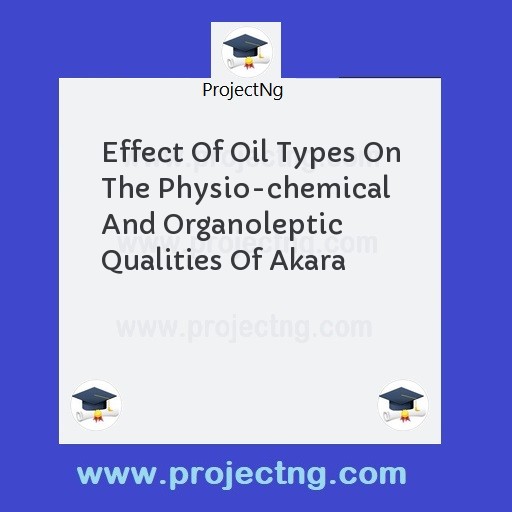Effect Of Oil Types On The Physio-chemical And Organoleptic Qualities Of Akara
Food Technology Project Topics
Get the Complete Project Materials Now! »
ABSTRACT
Akara is a tasty snack enjoyed by different sections of the population. This project investigated the effect of oil type on the sensory and chemical properties of akara produced from three different oil samples. The cowpea samples were soaked, washed, dehulled, grind, mixed with ingredients, and fried in the various oil samples. The results of sensory evaluation and proximate analysis indicate a level of significant difference, with WOW, XOX and YOY having the following results Protein 10.39a, 9.36b, 9.26b, fat: 22.72b, 27.85a, 26.56a, Ash: 1.86ac, 1.74bc, 2.06a, Fibre: 3.27a, 3.3a, 3.18a, moisture 50.33b, 51.76b, 7.33b respectively, also sample Wow showed the most significant difference amongst the samples on the basis of organoleptic property.
TABLE OF CONTENTS
Title page
Certification
Dedication
Acknowledgment
Abstract
Table of contents
CHAPTER ONE
- Introduction
CHAPTER TWO
- Literature Review
- History of cowpea
- cowpea
- Growth habits
- Cultivation
- Characteristics of cowpea
- Utilization and nutritional qualities
- Diseases
- Varieties
- Harvesting
- Drying and storage
- Uses of cowpea
- Types of oil used for frying
- Soyabean oil
- Unsaturated fatty acid in soyoil
- linoleni acid
- oleic acid
- saturated fatty acid in soyoil
- Stearate acid
- Palmitate acid
- Groundnut oil
- palm kernal oil
- Soyabean oil
- Effect of frying on oil
- Anisidine value
- Polar components
- Colour of oils
- Smoke point
- Evaluation of frying medium used in he production of Akara
- Use of charcoal as a frying medium
- Use of firewood as a frying medium
- Use of gas burner
CHAPTER THREE
- Materials and methodology
- Materials/apparatus
3.1.2. Methodology
-
- Quality parameters of the proximate analysis of the akara
- Determination of protein
- Determination of fat content
- Determination of crude fibre
- Determination of total ash
- Determination of carbohydrate
- Determination of moisture content
- Quality parameters of the proximate analysis of the akara
CHAPTER FOUR
- Result an discussion
- Result of proximate composition of akara fried with different types of oil.
- Result of the organoleptic scores of akara fried with different types of oils
CHAPTER FIVE
- Conclusion and recommendation
- Conclusion
- Recommendation
References
Appendix
INTRODUCTION
-
- BACKGROUND OF THE STUDY
The word Akara is Yoruba. In West Africa they call it Akara, in North West Africa and Ghana they call it Kose which is still Akara. Akara is called Akareje in Bahia and Brazil. Akara is “food” for the God’s. In Yoruba mythology and religion many deities and divinities eat Akara. Most of these deities are personified. Orisa Ibeje (goddess of twins) eats Akara, Ogun (god of Iron) eats Akara. Obatala (god of creation) eats Akara sangos (god of thunder) eats Akara. Olokun (goddess of the sea) eats Akara. Orunmiula (the custodian and the father of all divinities) eats Akara. Over 500 million West African eat Akara. Daily Akara is gluten free, dairy free and vegan friendly. The context of the sacred diet which Akara constitutes the ingredients most be pure. (www.tribaltastes.com).
Akara (Black eyed pea fritters) vigna-unguiculata, usually called cowpeas in English speaking Africa, also called China beans, and black eyed beans) are native to Asia, the middle East, and perhaps Africa. They were cultivated in the mediterranean region in ancient times, and have been grown all over Africa for centuries. In Western Africa they are used to make a batter from which fritters are made. These fritters (known as accra, akara, akla, binch akara, bean balls, kosai, koose, kose, koose and kwasi) are commonly prepared at home for breakfast, for snacks, or as an appetizer or side dish. They are also fast food, sold by vendors on the street in market places and at bus stations. The same recipe, with a very similar name is also known in the carribbean (www.congocookbook.com).
-
- AIM AND OBJECTIVES
AIM: To assess the effect of oil types on the pysiochemical and sensory properties of fried bean balls (Akara).
OBJECTIVES
To determine the physiochemcial properties of fried bean balls (akara) such as the
Crude fibre
Crude protein
Moisture
Carbohydrate
Ash
Fat
To determine the sensory quality of “akara” obtained from the use of PALM KERNEL OIL, GROUNDNUT OIL and SOYBEAN OIL in terms of the
Colour
Aroma
Taste
-
- JUSTIFICATION OF THE STUDY
Although this research is a requirement for the award of higher national diploma, this study is also targeted at discovering the effects of different types of frying oil on the physiochemical properties of fried beans balls (a product which is usually or readily consumed by students as a tasty snack).
It also focuses on the prediction of the acceptability of the product based on the acceptance of that obtained from an oil type, which will eventually transform the economic life of the retail snack sellers.
It also intends to determine the health risk possibility on the part of the consumers of “akara” produced from an oil types.
-
- SCOPE OF THE STUDY
This work covers the processing of beans into processed beans cake. It also encircles the analyses of the products to investigate the physical, chemical and sensory properties (sensory appeal) of the products as a means to determining the type of oil which is best for making “akara”.
This work, however, does not encompass the investigation of the shelflife of the products it also does not involve scaling up of the composition of the bean slurry (ie extra addition of other ingredients apart form the conventional ones) to produce a new “akara” taste.
Be the First to Share On Social

Enjoying our content?
Don't miss out on new videos! Subscribe to our YouTube channel for more awesome content.
Subscribe Now!













